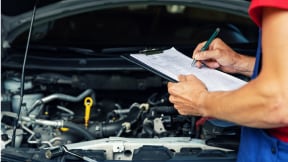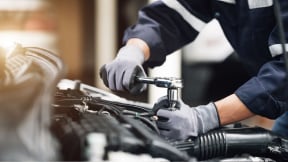Breaking in a new car: Is it necessary?

What do car parts like your engine, tire and brakes have in common with a new baseball glove or pair of shoes? They all might benefit from a little break-in period before really hitting their stride. You may have heard that some car manufacturers advise new car owners to “break in” their new vehicle to minimize excess stress and wear on the vehicle’s most vital machinery — but is breaking in a new car really necessary? Let’s find out.
Do you have to break in a new car?
“Breaking in” a car, or gradually easing it into more strenuous day-to-day use, has typically been a standard practice through the years. However, as cars have become more mechanically robust and technologically advanced, the idea of breaking in new vehicles may be less common among new car owners. However, you might still benefit from following a few breaking in processes to give your new car’s parts some time to kick into gear.
Check for manufacturer’s guidelines
Generally, manufacturers provide guidance as to how you should handle the first 500 –1,500 miles of your new vehicle's life. Choosing not to follow your manufacturer’s guidelines may come at an eventual cost in the form of extra wear and tear on your new car — particularly when it comes to components like your drivetrain or engine. With this in mind, you might benefit from a powertrain warranty in case either of these is impaired down the line.
How to break in a new car
While it’s best to follow your owner’s manual, there are also some general tips you might apply to breaking in a new car.
Avoid over-exhausting your engine
Understanding how internal combustion engines work may go a long way toward understanding the importance of breaking in your car. A common temptation of new car ownership may be to put your engine through its paces and see how far you can push it. Generally, however, it’s often suggested to keep the engine under 4,000 rpm within the first few hundred miles or so. If you’re driving a manual transmission, this may mean avoiding revving the engine and “redlining” it before shifting gears, as accelerating rapidly during your engine’s early days may cause unnecessary strain on your engine's core components, like the piston rings.
Instead of pushing your new engine to its limits right away, it may be better for your car’s long-term health to practice gentler driving at first and ease into things slowly. Accelerating smoothly and controllably may help maximize your engine's performance and longevity.
Avoid towing for now
It could be wise to avoid towing anything for your new car’s initial break in period. Towing a trailer, boat or anything else may cause additional load on your engine as it works overtime to pull the extra weight. Putting your engine through unnecessary stress early during its break in period may cause complications and accelerate deterioration.
Brake slowly and cautiously
To maximize your braking performance, consider “bedding-in” your new vehicle’s brake pads and rotors by carefully and gradually applying your brakes early on. This helps to gradually heat your brake pads, enabling them to deposit an even layer of pad material, also known as the “transfer layer,” onto your brake rotors. This transfer layer acts as a barrier between the metal surfaces of your braking components to potentially reduce abrasion and prevent them from grinding down.
Give your tires time
New tires may require a break in period before they can deliver optimal traction. The process of manufacturing tires includes applying a release lubricant, which prevents tires from sticking into the mold they are shaped in. New tires on your car may still have some of that lubrication present when you’re handed the keys, which might reduce your initial tire traction. A break-in period with easy acceleration, careful cornering and cautious breaking will allow the mold lubrication to slowly wear off and provide better traction.
Minimize stop-and-start driving
For drivers learning how to break in a new car intended for urban driving, it may be important to try and minimize driving in stops-and-start conditions when possible. Smooth, prolonged acceleration may help your engine warm up at a consistent rate and avoid overexertion in its early days. Additionally, this may help prevent your brake pads from heating up sporadically, which could impact how evenly your transfer layer is applied to the rotor.
While these general tips may be effective at breaking in a car, it’s best to follow your owner’s manual for guidance on the process for your make and model. This may potentially help you spend a little less money in the form of maintenance during your car’s later years. As they say, prevention is often better than a cure.
Breaking in a new car: Additional considerations
Besides learning about the specific factors mentioned above, there are some additional considerations to breaking in a car that could be important to keep in your back pocket.
Consider your break in period as maintenance
Properly maintaining your car is vital to keeping it operating at tip-top performance. Consider breaking in a car as the start of your vehicle’s lifetime maintenance schedule. Like most car owners, you likely want your ride to stay reliable for as long as possible. Being diligent with maintaining your vehicle may help it to stay in mint-condition longer, possibly preventing costly mechanical issues while helping to maintain the car’s resale value.
Breaking in an electric vehicle
If you purchased a new electric vehicle, your process to break in a car may look different. Electric motors typically have fewer moving parts, so their engines may not require as much breaking in as combustion-powered cars. On the other hand, EVs are typically heavier and tend to produce more torque, which may require additional care to keep your tires and brakes from wearing out faster. As always, it’s best practice to check out your owner’s manual for the manufacturer’s recommendations and adhere to those.
In summary
While it may not be as important to break in your new car as it was in the past, your owner’s manual may still have suggestions that could be worth following. In the end, breaking in a new car is like the early stages of any new venture — taking the time to walk before you run (so to speak) may help optimize the health and performance of your car for the long-term and potentially save you maintenance costs in the future.



